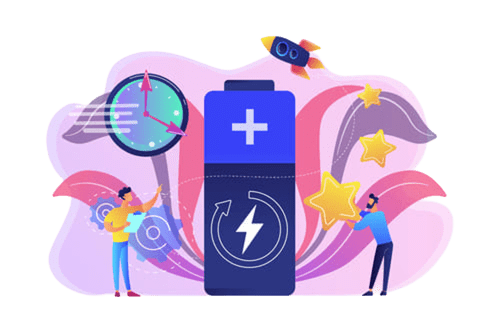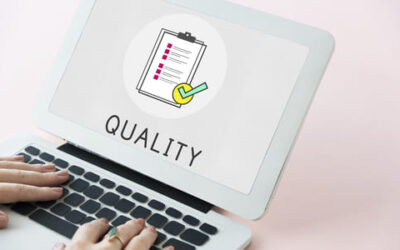Coaching and mentoring, while distinct in theory, often overlap in practice. Both aim to foster personal and professional growth. Context plays a key role in determining which approach is most effective, with organizations blending elements of both to meet diverse developmental needs.
The Future of Batteries: How Organic Batteries Are Changing the Game
Batteries power almost every aspect of modern life: smartphones, laptops, electric vehicles, smartwatches, and even large-scale energy storage solutions for renewable energy.

Why We Need a Battery Revolution
Batteries power almost every aspect of modern life: smartphones, laptops, electric vehicles, smartwatches, and even large-scale energy storage solutions for renewable energy. But traditional batteries, particularly lithium-ion batteries, come with significant problems:
❌ Environmental impact: Mining metals like lithium and cobalt leads to habitat destruction, pollution, and resource depletion.
⚡️ Resource limitations: Lithium and cobalt are finite and their availability depends on specific regions, leading to supply chain issues.
🔴 Toxicity and waste: Used batteries contribute to electronic waste, and recycling is expensive and inefficient.
⚠️ Safety risks: Lithium-ion batteries can overheat, catch fire, or explode, as seen in some high-profile incidents.
So, what if we could create safer, cheaper, and more sustainable batteries? That’s where organic batteries come in.
In this article, we’ll dive into what organic batteries are, how they work, their advantages, current research breakthroughs, and what the future holds for this exciting technology.
What Are Organic Batteries?
Organic batteries are carbon-based energy storage devices that use organic molecules instead of metal-based compounds. Unlike traditional batteries that rely on metal oxides (like lithium-ion or nickel-cadmium batteries), organic batteries use materials like:
- Carbon-based polymers
- Biodegradable molecules
- Redox-active organic compounds (compounds that can easily gain or lose electrons)
These organic materials can be sourced from biodegradable or renewable sources, making them eco-friendly and more sustainable than traditional batteries.
🌱 Key Differences Between Organic and Traditional Batteries
| Feature | Traditional Batteries | Organic Batteries |
|---|---|---|
| Main Material | Lithium, Cobalt, Nickel | Carbon-based organic molecules |
| Availability | Limited to certain regions | Abundant & renewable |
| Environmental Impact | High (toxic mining, waste) | Low (sustainable, biodegradable) |
| Safety | Can overheat & explode | Safer, non-toxic |
| Flexibility | Rigid, heavy | Can be lightweight & flexible |
Why Organic Batteries Are the Future
1. Eco-Friendly and Sustainable
🌿 Less Mining, Less Damage: Unlike lithium-ion batteries, which require extensive mining operations, organic batteries use naturally occurring or synthetic organic materials that don’t deplete the Earth’s resources.
🌳 Biodegradability: Many organic compounds break down naturally, reducing battery waste pollution.
2. Cheaper & More Accessible Materials
💲 No Expensive Metals: Traditional batteries require lithium and cobalt, which are limited and expensive. Organic batteries use carbon-based materials that can be synthesized from renewable sources.
🚀 Local Manufacturing: With organic materials, countries can produce their own batteries without relying on specific mining regions, making supply chains more resilient.
3. Safer & More Flexible
🏢 Non-Toxic & Fire-Resistant: No risk of dangerous chemical leaks or explosions, unlike lithium-ion batteries.
🌀 Bendable & Flexible: Organic batteries can be thin, stretchable, and even transparent, making them ideal for next-gen wearables, foldable phones, and medical devices.
4. Faster Charging & Longer Lifespan
🌟 Rapid Charging: Many organic battery designs charge faster than lithium-ion.
💪 Longer Lifespan: They have a higher cycle life, meaning they last more charging cycles before degrading.
%
job satisfaction
A survey conducted by the American Psychological Association found that nearly 70% of employees believe that work-life balance is a critical factor in their job satisfaction, and employees with a good work-life balance are 21% more productive than those without.
%
reduction in absenteeism
According to the 2023 Global Employee Well-Being Index, companies with comprehensive well-being programs see a 56% reduction in absenteeism and a 27% increase in employee retention, highlighting the significant impact of well-being initiatives on overall employee performance and loyalty.
How Do Organic Batteries Work?
Organic batteries function using redox reactions, just like conventional batteries, but with organic compounds acting as the electron donors and acceptors.
🔋 Main Components of an Organic Battery
- Organic Electrodes: Instead of metal oxides, organic electrodes store and release energy through redox reactions.
- Electrolytes: The medium that carries charge (can be water-based or solid-state).
- Organic Conductors: Organic materials that help electrons move through the battery.
Types of Organic Batteries
🔄 Organic Redox Flow Batteries (ORFBs)
- Store energy in liquid organic molecules
- Ideal for large-scale energy storage (solar/wind farms)
🧀 Organic Lithium-Ion Batteries
- Replace metal-based cathodes with organic materials
- Work like lithium-ion but greener and safer
🎨 Polymer-Based Organic Batteries
- Use conductive polymers for flexible applications
- Great for wearable tech
Future of Organic Batteries
🚀 Future Applications of Organic Batteries
📱 Smartphones & Laptops – Faster charging, safer, and more eco-friendly devices.
🏠 Renewable Energy Storage – Storing solar & wind energy for 24/7 power.
👨💼 Wearable Tech – Smartwatches & health trackers powered by flexible organic batteries.
🚗 Electric Vehicles – Sustainable, high-performance EV batteries.
🛠 Challenges & What’s Next
👁 Stability Issues – Some organic materials degrade over time.
💪 Energy Density – Needs improvement to match lithium-ion batteries.
🏢 Scaling Production – Making organic batteries affordable and mass-producible is key.
🎉 Final Thoughts: Are Organic Batteries the Future?
Organic batteries are on the rise, offering safer, greener, and cheaper alternatives to traditional batteries. As research progresses, we can expect longer-lasting, flexible, and biodegradable batteries powering our future devices.
Would you switch to an organic battery-powered phone or car? Let us know! 📲🚀
Conclusion
Agile auditing is a transformative approach that allows audit departments to be more flexible, responsive, and aligned with organizational priorities. By focusing on collaboration, continuous feedback, and delivering value incrementally, Agile auditing offers a significant improvement over traditional audit methods.
However, implementing Agile auditing is not without its challenges. Cultural resistance, resource constraints, and the risk of compromising audit quality are all factors that organizations must navigate carefully. With the right mindset, leadership, and tools, Agile auditing can become a powerful tool for organizations to better manage risks and deliver timely, relevant insights to stakeholders.
References
- Catlin, Raven, and Watkins, Ceciliana. Agile Auditing: Fundamentals and Applications. Wiley
- PricewaterhouseCoopers. Staying the Course Toward True North: Navigating Disruption. State of the Internal Audit Profession Study
- Agile Alliance. “Manifesto for Agile Software Development.” agilemanifesto.org.
- Schwaber, Ken, and Jeff Sutherland. The Scrum Guide. Scrum Inc.
- Project Management Institute. A Guide to the Project Management Body of Knowledge (PMBOK Guide), 6th Edition. PMI
- Wright, Rick. Agile Auditing: Transforming the Internal Audit Process. Internal Auditor Magazine
Wanna know more? Let's dive in!
The Professionalization of Mentoring Practices
Unlocking the full potential of mentoring means tackling some key issues head-on, like integrating the latest research, following best practices, understanding the dynamics of mentoring relationships, and aligning goals between mentors and mentees.
Holistic Mentoring Framework
The Holistic Mentoring Framework offers a holistic approach to mentoring, focusing on professional development, emotional well-being, and individualized support. By fostering trust and nonjudgmental relationships, it empowers early career professionals across industries to thrive, promoting continuous growth and addressing their unique challenges.
Best Practices in Mentoring: A Comprehensive Guide
Mentoring is like your personal growth hack. It’s all about connecting with someone who’s been there, done that, and leveling up together. It’s not just career tips – it’s real talk, learning, and support that helps you crush your goals.
ISO 9001 Gets a Glow-Up: Climate Edition
ISO 9001 Goes Green: The iconic quality management standard now includes climate action, pushing businesses to integrate eco-friendly practices. Get ready for a greener, cleaner approach to quality that’s all about saving the planet—one process at a time.
Integration to Face Modern Quality Challenges in Automotive: A Holistic Approach
A comprehensive approach to addressing modern automotive quality challenges by integrating design, functional safety, and Lean Six Sigma methodologies, fostering collaboration among experts to ensure reliable, safe, and high-performance vehicles in an increasingly complex technological landscape.
The Evolution of SPICE A Comprehensive Journey Through Process Assessment Standardization
A groundbreaking initiative, SPICE (Software Process Improvement and Capability dEtermination) paved the way for standardized process assessments. This retrospective explores its journey from inception to global adoption, highlighting the development of ISO/IEC 15504 and its lasting impact on software engineering and other industries worldwide.
Revolutionizing Automotive Testing with Evidence-Based Software Engineering
Discover how automotive software testing processes enhances using Evidence-Based Software Engineering. This approach identifies key challenges, integrates industry best practices, and leverages empirical evidence to improve testing efficiency, quality, and compliance. Learn actionable strategies to streamline testing, manage requirements, automate processes, and ensure high safety standards in automotive software development.
The Path to Resilient Supply Chains: Empirical Insights and Strategic Approaches
As global supply chains become more complex and susceptible to disruptions, businesses must prioritize resilience to maintain stability and performance. This article explores empirical findings and strategic approaches to enhance supply chain resiliency, highlighting the importance of diversification, technology investment, strong supplier relationships, and proactive risk management practices.
Understanding Project Success: Perspectives from Different Stakeholder Groups
Understanding and aligning different stakeholder perspectives is crucial for achieving project success. This study explores how varying interpretations of project success criteria among senior management, project teams, and recipients can lead to project failure. A multiple stakeholder model is proposed to enhance collaboration and reduce the risk of unsuccessful outcomes.
Understanding Organizational Constraints and Their Impact on Employee Engagement: A Comprehensive Overview
Explore how organizational constraints impact employee work engagement and why aligning team perceptions of these constraints is crucial for fostering a motivated and productive workforce. This article delves into the types of constraints, the role of perceptual congruence, and practical strategies for enhancing engagement in the workplace.
Innovative Built-In Screening Methodology: Driving Towards Zero Defects in Automotive Microelectronics
Introducing a built-in screening methodology to detect gate oxide and crystal defects in automotive microelectronics, enhancing reliability and reducing costs. This innovative approach minimizes the need for traditional external testing, ensuring robust quality assurance and moving closer to the industry’s goal of zero defects.











